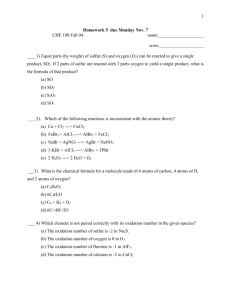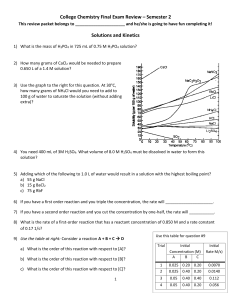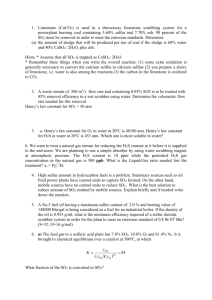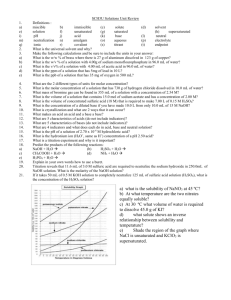Enthalpy - Career Launcher
advertisement
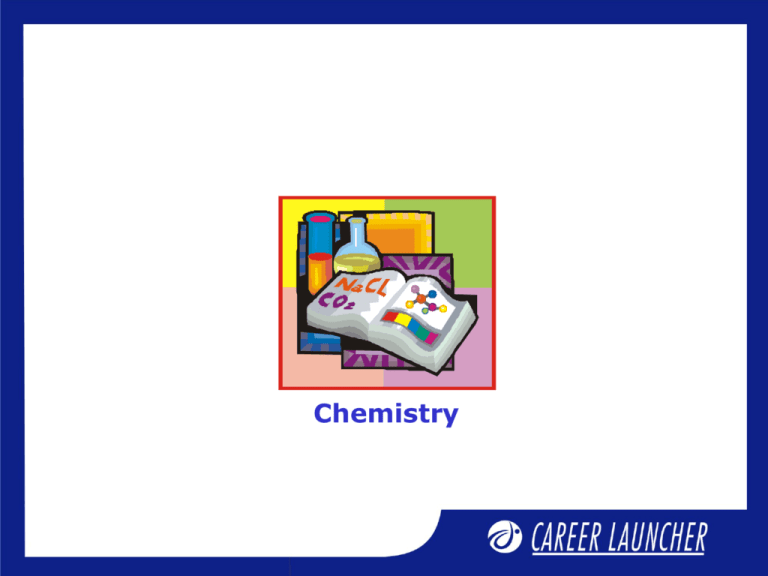
Chemistry Session Objectives 1. Occurrence of group 16 elements 2. Oxidation state and trends in chemical reactivity 3. Extraction of sulfur 4. Oxoacids 5. Sulfuric acid: process and properties Group 16 elements: Chalcogens Oxygen O [He] 2s2 2p4 Sulphur S [Ne] 3s2 3p4 Selenium Se [Ar] 3d10 4s2 4p4 Tellurium Te [Kr] 4d10 5s2 5p4 Polonium Po [Xe] 4f14 5d10 6s26p4 Occurrence Oxygen is the most abundant of all elements and exists in free form as O2. Liquid O2 is pale blue and paramagnetic in nature. Oxygen occurs as two non-metallic forms — dioxygen O2 and ozone O3 Ozone, O3, can be easily liquified as compared to O2, It is a dark blue, unstable liquid. Sulphur occurs as sulphide ores and as sulphates can be obtained from volcanoes. Sulphur occurs as octaatomic molecule S8 ring form Selenium and tellurium Selenium and tellurium occur in sulfide ores; they are also recovered from the refining of copper. Selenium occurs as Se8 rings. Tellurium occurs as Te8 rings. Polonium is mono atomic. Selenium conducts electricity when exposed to light, so it is used in solar cells, light meters, and photographic materials. Its most important use is as the lightsensitive component in photocopy machines. Physical properties of group16 elements Atomic size, density, melting point and boiling point increase down the group. Polonium has less melting point and boiling point than tellurium due to inert pair effect. Ionisation potential, electronegativity and electron affinity decrease down the group. Non-metallic nature decreases and metallic nature increases down the group. Extraction of sulfur Sulphide ores are widely distributed, including galena(PbS). Cinnabar(HgS), pyrite(FeS2) and sphalerite(ZnS). Sulfur is recovered from natural gas by first separating H2S through absorption in monoethanolamine. Recovered H2S is passed over a catalyst Fe2O3 in the presence of air where H2S is partially converted into SO2 and then SO2 reacts with H2S and form Sulfur. 3 H2S O2 SO2 H2O 2 3 Fe2O3 , 673 K 2H2S(g) SO2 S8 (g) 2H2O 8 The Frasch Process Sulfur is also obtained from oil and gas deposits and is recovered in the refining process. Uses of S and its Oxides Uses of S, Se and Te Most important application of sulfur is in manufacturing of H2SO4. Se is used in Xerox machines as a photoconductor. It is an essential element in the body. It is an important component of enzymes. Te is used as an additive in metallurgy. Te is also highly toxic. Allotropy and Polymorphism Sulphur has more allotropic forms than any other element.These forms arise partly from the extent to which S has polymerised. Most important are Rhombic or octahedral or a form Monoclinic or prismatic or b form Rhombic and monoclinic forms undergo reversible changes at 368.5 K (transition temperature) The S2 molecule is paramagnetic and blue coloured like O2 A piece of sulfur melts to a blood-red liquid. When burned, it emits a blue flame. Oxidation State Except oxygen chalcogens exhibit –2, +2, +4 and +6 oxidation states oxygen exhibits –1 oxidation states in peroxides, +1 in O2F2 and +2 in OF2 . Common oxidation state of oxygen is –2. Oxygen is a powerful oxidising agent and H2Se and H2Te are reducing agents. S, Se and Te are mostly exists in positive oxidation states. +4 in SF4, SO2, H2SO3 and + 6 in SF6, SO3, H2SO4. Hydrides H2O is liquid, others are colourless foul smelling toxic gases. Bond length increases down the group. Bond energy decreases down the group. Volatile nature decreases, Acid strength: H2O < H2S < H2Se < H2Te < H2Po Reducing nature: H2O < H2S < H2Se < H2Te < H2Po Thermal stability: H2O > H2S > H2Se > H2Te > H2Po Halides General formula of halides M2X2, MX2, MX4 and MX6, sp3d2 hybridisation Hexahalides: e.g SF6, SeF6, TeF6 Chemical activity increases from SF6 to TeF6. SF6 is inert. It does not undergo hydrolysis, others undergo hydrolysis Tetrahalides: Except O, all elements form tetrahalides of chalcogen sp3d hybridisation distorted trigonal bipyramidal shape.On hydrolysis give ‘ous’ acid. Halides Dihalides: Except Se, all can form dihalides. SCl2 has foul smell. The oxidation number of S in SCl2 is +2 and its hybridisation is sp3 and is angular shaped. SCl2 on reacting with ethylene, gives mustard gas. Mustard gas; S(CH2CH2Cl )2 Monohalides: S2Cl2 is toxic yellow liquid. Its structure is open book like and has an angle of 104°. The oxidation number of S in S2Cl2 is +1. It is used in vulcanization of rubber. Halides Sulfur reacts readily with all the halogens except iodine. It ignites sponteneously in flourine and burns brightly to give hexaflouride. SF6 is colourless, tasteless, odourless, nontoxic, thermally stable, and insoluble. Despite the +6 oxidation state of S, it is not a good oxidising agent .Its inertness is due to presence of sterically protected sulphur atom It is a much better insulator than air. Oxides Chalcogens form dioxides and trioxides — acidic nature decreases from oxides of S to Po. Dioxides dissolve in water to form ous acids trioxides form ‘ic’ acids. SO2 H2O H2SO3 SO2 NaOH NaSO3 H2O SO3 H2O H2SO4 SO3 NaOH Na2SO4 H2O TeO3 H2O H2TeO4 Illustrative problem Explain why H2S acts only as a reducing agent but SO2 acts both as reducing agent as well as oxidising agent Solution: The minimum oxidation state of S is -2 and its maximum oxidation State is+6.In SO2 the oxidation state is +4 so it can be reduced +2 oxidation state or can be oxidised to +6 oxidation state so it can act both as oxidising agent as well as reducing agent.On the other hand In H2S S has oxidation state as –2 so it can only increase its oxidation state by loosing electrons and hence can act only as reducing agent. Oxyacids of sulphur Manufacture of Sulfuric Acid There are two major processes used in the production of H2SO4, lead chamber process and contact process. The lead-chamber process is the older of the two processes, and its product is aqueous sulfuric acid containing 62% to 78% H2SO4. Solid sulfur, S(s), is burned in air to form sulfur dioxide gas, SO2 S(s) + O2(g) SO2(g) The mixture of sulfur dioxide and air is heated to 450oC and subjected to a pressure of 1 -2 atm in the presence of a catalyst (vanadium (V) oxide) to produce sulfur trioxide, 2SO2(g) + O2(g) 2SO3(g) SO3 is absorbed in 98% H2SO4 to form oleum . SO3(g) + H2SO4 H2S2O7 Sulfuric Acid Oleum on dilution with water gives desired concentration of HSO4H2S2O7(l) + H2O(l) 2H2SO4(l) The best way to dilute sulphuric acid is to carefully pour the acid into water with stirring Pure sulfuric acid is a colourless, corrosive, oily liquid that boils(and decomposes) at about 300oC. It has three very important properties: strong acid, dehydratig agent, oxidizing agent. Dehydrating Nature Concentrated acid (18M) is used as a dehydrating agent. e.g., sulfuric acid dehydrate sucrose, to produce a spongy mass of carbon. C12H22O11(s) + 11H2SO4 12C(s) + 11H2SO4.H2O Oxidising Nature Oxidising power is intermediate between phosphoric and nitric acids. Both metals and non-metals are oxidised by concentrated sulfuric acid, which is reduced to SO2. C H2SO4 CO2 2SO2 2H2O Cu 2H2SO4 CuSO4 SO2 2H2O With Zn, the reduction of sulfuric acid goes further to give sulfur or H2S. Uses of Sulfuric Acid Used in lead acid batteries, production of fertilizers (NH4)2SO4, superphosphate, Ca(H2PO4)2, to remove oxides from iron and steel before galvanising or electroplating, petrochemicals, dyestuffs, and detergents.. Used in the production of nitroglycerine, which is used as an explosive but can also be used as a vasodilator, a substance that dilates blood vessels and can be used in the treatment of certain types of heart disease. Illustrative Problem A yellow powder is burnt in a stream of F2 to obtain a colorless gas X which is thermally stable and has octahedral geometry. Another gas with same atoms as that of Y is obtained when SCl2 is heated with NaF. What are X and Y? Solution : S 3F2 SF6 SC 2 NaF SF4 Environmental Issues • Smog consists mainly of particulate (ash and smoke), SO2 and H2SO4 mist. – Main contributor is the emission of SO2. – Acid rain. – Levels of SO2 and H2SO4 above 0.10 ppm are considered potentially harmful. • Especially to respiratory tract. Thank you
